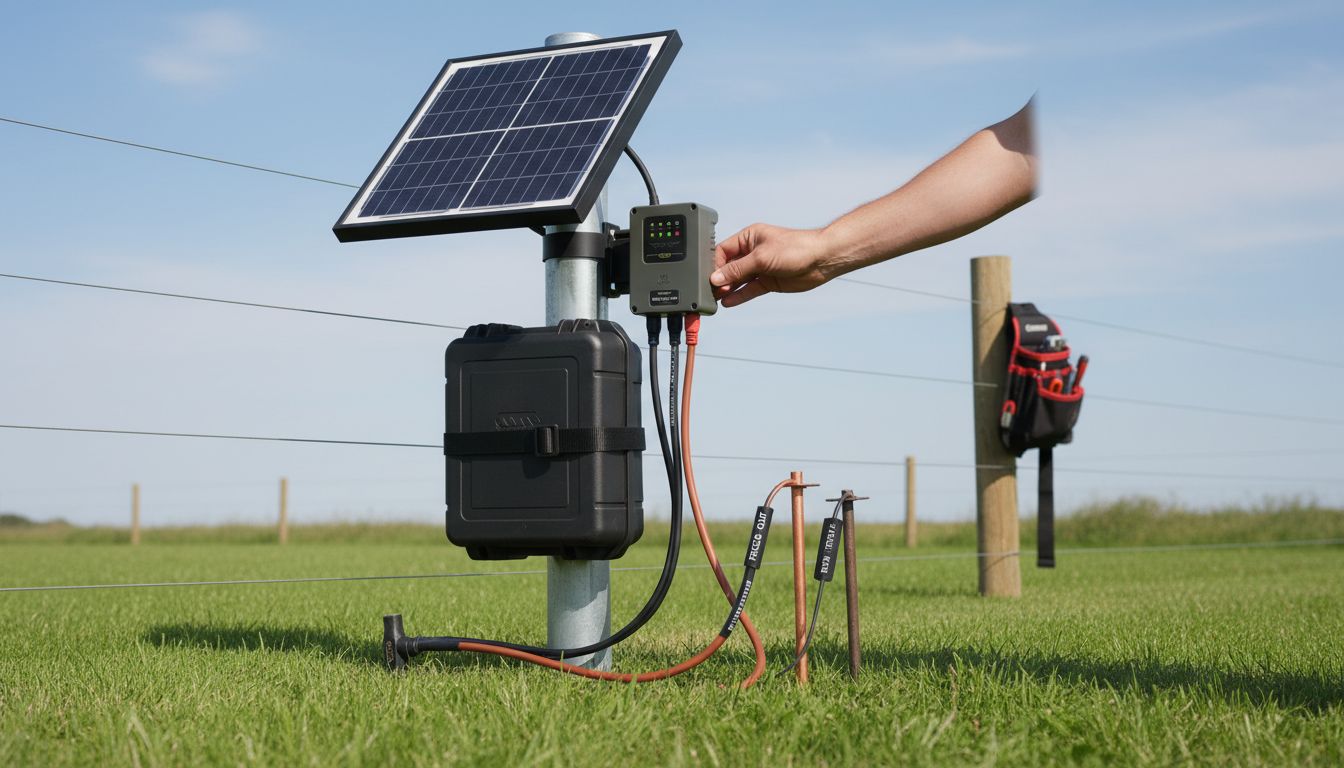More than 60 percent of farms now rely on electric fencing, and solar-powered systems are quickly gaining ground. Managing livestock in remote areas used to mean constant worries about power cuts or expensive infrastructure upgrades. Solar electric fence chargers take that worry away by offering round-the-clock power anywhere sunlight reaches. This article breaks down how these innovative chargers work, compares their types, and highlights the advantages that make them a smart choice for modern farms.
Table of Contents
- Solar Electric Fence Chargers Explained
- Main Types And Power Sources Compared
- Key Features And Performance Factors
- Installation, Maintenance, And Safety Tips
- Comparing Solar Vs. Electric Fence Chargers
Key Takeaways
| Point | Details |
|---|---|
| Solar Independence | Solar electric fence chargers offer complete energy independence, making them ideal for remote areas without electrical infrastructure. |
| Cost-Effectiveness | These systems provide minimal ongoing operational costs, reducing long-term expenses for agricultural professionals. |
| Environmental Benefits | Solar chargers represent a sustainable and green solution, minimizing environmental impact compared to traditional electric systems. |
| Performance Factors | Key factors to consider when selecting a solar electric fence charger include joule rating, impedance, and proper grounding for optimal effectiveness. |
Solar Electric Fence Chargers Explained
Solar electric fence chargers represent a revolutionary approach to livestock management and perimeter security, transforming how agricultural professionals power their fencing systems. According to research from scitepress.org, these innovative devices convert solar energy into a reliable electrical pulse system that can operate completely independent of traditional power grids.
Solar electric fence chargers are sophisticated power management systems designed to deliver controlled electrical pulses along fence wires. The core components typically include:
- Solar photovoltaic panels
- Rechargeable battery storage system
- Fence energizer/charger unit
- Voltage regulation mechanisms
As detailed by nrel.gov, these systems work by capturing sunlight through solar panels, which then charge a battery bank. The stored energy powers the fence charger, generating periodic high-voltage pulses that create a psychological and physical barrier for livestock containment or predator prevention.
The primary advantage of solar electric fence chargers is their versatility and reliability in remote locations. Farmers and ranchers can now establish secure perimeters in areas without direct electrical infrastructure, ensuring continuous operation through integrated battery storage and sustainable solar charging. These systems provide a green, cost-effective solution for managing livestock boundaries while minimizing environmental impact and ongoing electricity expenses.
For those considering implementing a solar electric fence system, our comprehensive guide on portable solar electric fences offers in-depth insights into selecting and installing the right equipment for your specific agricultural needs.
Main Types and Power Sources Compared
Electric fence chargers come in three primary power configurations, each designed to meet specific agricultural and livestock management needs. According to canr.msu.edu, these configurations include plug-in, solar-powered, and battery-powered systems, each offering unique advantages for different scenarios.
Here’s a comparison of the three main types of electric fence chargers:
| Feature | Plug-In Electric Charger | Solar Electric Charger | Battery-Powered Charger |
|---|---|---|---|
| Power Source | Electrical outlet | Sunlight + battery | Replaceable batteries |
| Installation Location | Fixed with grid access | Anywhere, remote | Portable, flexible |
| Ongoing Operating Cost | Moderate | Minimal | Battery replacement |
| Environmental Impact | Uses grid electricity | Sustainable, green | Moderate |
| Ideal For | Permanent large fences | Remote or off-grid | Temporary/mobile use |
| Maintenance Requirements | Low | Moderate (clean panels, check battery) | Low (check batteries) |
| Initial Equipment Cost | Lower | Moderate to higher | Moderate |
Plug-In Electric Fence Chargers
Plug-in chargers remain the most traditional power source, providing consistent and reliable electrical output when connected to standard electrical outlets. Characteristics include:
- Highest consistent power output
- Lower initial equipment cost
- Ideal for fixed locations with reliable electricity
- Typically most cost-effective for large, permanent fence installations
Solar-Powered Electric Fence Chargers
Solar electric fence chargers represent the most flexible and environmentally friendly option. As highlighted by agresearch.montana.edu, these systems excel in remote locations without direct electrical access. Key benefits include:
- Complete energy independence
- Minimal ongoing operational costs
- Adaptable to various terrain and landscape conditions
- Sustainable power generation
Battery-Powered Electric Fence Chargers
Battery-operated chargers offer maximum portability and are perfect for temporary or mobile fencing requirements. These units provide:
- Maximum location flexibility
- Quick setup and breakdown
- Ideal for rotational grazing
- Suitable for smaller pasture areas
![]()
Selecting the right electric fence charger depends on several critical factors: your specific livestock type, fence length, terrain, and proximity to electrical infrastructure. our comprehensive guide on portable solar electric fences can help you make an informed decision tailored to your unique agricultural needs.
Key Features and Performance Factors
Selecting the right solar electric fence charger requires understanding critical performance characteristics that determine effectiveness and reliability. According to canr.msu.edu, several key factors play a crucial role in determining a charger’s overall performance and suitability for different agricultural environments.
Voltage and Energy Output
Joule rating is the primary measure of an electric fence charger’s power capability. This metric determines the system’s ability to maintain consistent electrical pulse delivery across various environmental conditions. Critical considerations include:
- Appropriate joule rating for specific livestock types
- Ability to penetrate vegetation and maintain consistent voltage
- Power output range typically between 0.1 to 5.0 joules
- Performance consistency in different weather conditions
Impedance and Electrical Efficiency
Low impedance design represents a critical technological advancement in electric fence chargers. This feature allows electrical pulses to maintain strength even when confronting vegetation, moisture, or other potential resistance sources. Key performance indicators include:
- Minimal energy loss through vegetation contact
- Faster pulse recovery rate
- Enhanced electrical system efficiency
- Reduced power consumption

Grounding and System Reliability
Proper grounding is perhaps the most overlooked yet essential aspect of electric fence performance. An inadequate grounding system can dramatically reduce the effectiveness of even the most advanced charger. Recommended grounding strategies involve:
- Multiple ground rod installations
- Proper rod depth and spacing
- Using copper or galvanized steel ground rods
- Ensuring low ground resistance (typically under 500 ohms)
For those seeking a deeper understanding of electric fence technologies, our comprehensive guide on portable solar electric fences offers additional insights into selecting the most appropriate system for your specific agricultural needs.
Installation, Maintenance, and Safety Tips
Proper installation and maintenance are crucial for ensuring the effectiveness and longevity of solar electric fence chargers. According to agresearch.montana.edu, a systematic approach to setup and ongoing care can significantly improve your fence’s performance and safety.
Installation Best Practices
Fence line preparation is the first critical step in creating an effective electric fencing system. Essential installation considerations include:
- Selecting appropriate fence wire and insulators
- Ensuring clear vegetation around fence perimeter
- Maintaining consistent tension in fence wires
- Positioning solar panels for maximum sunlight exposure
Grounding and Electrical System Setup
Proper grounding represents the most critical technical aspect of electric fence installation. Recommended techniques involve:
- Installing multiple ground rods (minimum 3 rods)
- Spacing ground rods at least 10 feet apart
- Using copper or galvanized steel ground rods
- Ensuring low ground resistance (under 500 ohms)
Routine Maintenance Checklist
Regular inspections are essential to maintain optimal fence performance. Key maintenance tasks include:
- Monthly voltage testing
- Cleaning solar panels
- Checking battery connections
- Trimming vegetation near fence lines
- Replacing damaged insulators or wire segments
Safety Precautions
As highlighted by canr.msu.edu, safety should always be the primary consideration. Critical safety recommendations include:
- Using warning signs around electric fence perimeters
- Keeping children and unauthorized personnel away
- Wearing insulated gloves during maintenance
- Disconnecting power before performing repairs
Our comprehensive guide on portable solar electric fences provides additional detailed insights for implementing a safe and effective electric fencing system.
Comparing Solar vs. Electric Fence Chargers
Choosing between solar and traditional electric fence chargers requires carefully evaluating their unique advantages and limitations. According to hobbyfarms.com, the decision hinges on several critical factors including power availability, location, and specific agricultural requirements.
Traditional Electric Fence Chargers
Plug-in electric fence chargers represent the most conventional power solution, offering consistent and reliable performance. Key characteristics include:
- Direct connection to electrical grid
- Highest consistent power output
- Lower initial equipment costs
- Ideal for fixed, permanent fence installations
- Unlimited operational hours
Solar Electric Fence Chargers
Solar-powered systems provide unprecedented flexibility for remote agricultural settings. As detailed by canr.msu.edu, these chargers excel in locations without direct electrical infrastructure. Distinctive features include:
- Complete energy independence
- Zero ongoing electricity expenses
- Environmentally sustainable power generation
- Adaptable to diverse terrain and landscape conditions
- Minimal long-term maintenance requirements
Comparative Performance Analysis
The choice between solar and traditional electric fence chargers depends on several nuanced factors:
- Power Reliability: Traditional chargers offer consistent power, while solar depends on sunlight availability
- Installation Complexity: Solar systems require more initial setup
- Long-Term Costs: Solar reduces ongoing electricity expenses
- Environmental Impact: Solar chargers have significantly lower carbon footprint
Our comprehensive guide on solar fence energizers provides additional insights to help you make an informed decision tailored to your specific agricultural needs.
Take Control of Your Livestock with Reliable Solar Electric Fence Solutions
Managing livestock boundaries in remote or off-grid areas can feel overwhelming when traditional power options are unavailable or costly. This guide highlighted the challenge of finding a dependable, weather-resistant solar electric fence charger that delivers consistent voltage while minimizing maintenance and reducing environmental impact. You want a system that offers powerful joule output, low impedance performance around vegetation, and solid grounding for safety and reliability.
FenceFast.ca understands these critical needs and provides a wide range of electric fencing products designed for Canadian farmers, ranchers, and rural homeowners. Whether you need premium solar-powered fence chargers for remote pastures or accessories to enhance fence longevity and performance, we have you covered.

Explore our selection today and experience the confidence that comes from using trusted equipment tailored to your agricultural challenges. Don’t wait for your livestock’s safety to be compromised by unreliable fencing. Visit FenceFast.ca now to find expert advice, durable fencing components, and dependable solar solutions that keep your boundaries secure year-round.
Frequently Asked Questions
What is a solar electric fence charger and how does it work?
A solar electric fence charger converts solar energy into electrical pulses, charging a battery system that powers the fence. It operates independently of the electrical grid, making it ideal for remote locations.
What are the advantages of using a solar electric fence charger?
Solar electric fence chargers provide energy independence, minimal ongoing costs, and environmental sustainability. They are versatile and can be set up in areas without access to traditional power sources.
How do I choose the right solar electric fence charger for my needs?
Consider factors like the type of livestock, fence length, terrain, and the joule rating of the charger. It’s essential to select a charger with the adequate power output to maintain effectiveness in your specific environment.
What maintenance is required for a solar electric fence charger?
Regular maintenance includes cleaning the solar panels, checking battery connections, testing voltage, and trimming vegetation near the fence line. Ensure grounding is properly maintained to optimize performance.
